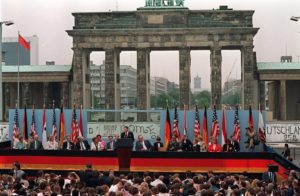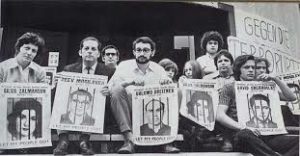 Just a week ago, President Trump signed an executive order suspending refugee resettlement and blocking access to the US for the nationals of seven predominantly Muslim countries in the Middle East. Opposition to this order came together incredibly swiftly, as thousands of Americans went to airports to protest this action.
Just a week ago, President Trump signed an executive order suspending refugee resettlement and blocking access to the US for the nationals of seven predominantly Muslim countries in the Middle East. Opposition to this order came together incredibly swiftly, as thousands of Americans went to airports to protest this action.
There are, I think, a lot of reasons that this executive order drew such widespread and immediate resistance. Some have been discussed at length. We think of ourselves as a nation of immigrants. And many, many of us have ancestors only a generation or two back who came to this country as members of despised minority groups. Many Americans also have friends, colleagues, loved ones, and relatives directly affected by the order. And, as sign after sign indicated, years of Holocaust education has taught most Americans that if they come for some other group, your group will be attacked soon enough.[1]
But one thing that hasn’t been remarked on quite so much was the centrality of restrictions on freedom of movement to American understandings of Soviet communism, especially during the latter half of the Cold War. Closed international borders were one of the key things separating the “Free World” from the Eastern Bloc. Tens of millions of Americans – all but the Millennials, really – who still remember this.
The great symbol of Communism’s reliance on closed borders was, of course, the Berlin Wall. Officially labelled the Antifaschistischer Schutzwall (Antifascist Protective Wall) by East German authorities, the wall was in fact designed to prevent East Germany citizens from leaving the country for West Germany. And from its initial construction in 1961, it served the West as an almost perfect symbol of Communist unfreedom.[2] In 1987, Ronald Reagan had his greatest Cold War moment standing in front of it and demanding that Gorbachev tear it down. And its eventual fall in 1989 is still conventionally seen as the end of the Cold War, despite the Soviet Union’s limping along for another couple years.
 The campaign for Soviet Jewry similarly emphasized the image of the USSR as a kind of country-size prison camp. Echoing Moses in the Torah, the slogan “Let My People Go” was central to this campaign. As a Jewish American growing up in the late 1960s and 1970s, I saw these images constantly.
The campaign for Soviet Jewry similarly emphasized the image of the USSR as a kind of country-size prison camp. Echoing Moses in the Torah, the slogan “Let My People Go” was central to this campaign. As a Jewish American growing up in the late 1960s and 1970s, I saw these images constantly.
While both the focus on the Wall and the campaign for Soviet Jewry were bipartisan, I believe they were strongest on the right. Conservatives, even more than liberals, presented international freedom of movement as one of the most important things that separated Us from Them.[3]
The association of closed borders with unfreedom in the minds of many Americans of my generation underscores what we experience as the visceral wrongness of Trump’s executive order, that it is not simply a policy one might disagree with, but something that violates a principle that people of my generation were taught was essential to the American way of life.
_______________________________
[1] No wonder the Trump administration converted this year’s Holocaust Remembrance Day into a Holocaust Denial Day in all but name.
[2] This notion was probably aided by the US removing nationality restrictions on immigration only a few years later with the Hart-Celler Act (1965).
[3] There was of course significant irony in this, given, e.g., the travel ban imposed by the US in the 1950s on Paul Robeson. But it’s wrong to expect consistency in Cold War ideologies.

One Thought on this Post
S-USIH Comment Policy
We ask that those who participate in the discussions generated in the Comments section do so with the same decorum as they would in any other academic setting or context. Since the USIH bloggers write under our real names, we would prefer that our commenters also identify themselves by their real name. As our primary goal is to stimulate and engage in fruitful and productive discussion, ad hominem attacks (personal or professional), unnecessary insults, and/or mean-spiritedness have no place in the USIH Blog’s Comments section. Therefore, we reserve the right to remove any comments that contain any of the above and/or are not intended to further the discussion of the topic of the post. We welcome suggestions for corrections to any of our posts. As the official blog of the Society of US Intellectual History, we hope to foster a diverse community of scholars and readers who engage with one another in discussions of US intellectual history, broadly understood.
Good post. A couple of thoughts:
A key congressional figure on the Soviet Jewry issue was Sen. Henry (Scoop) Jackson (cf. Jackson-Vanik amendment), a sort of right-center in some ways or neocon-ish Democrat. So while the campaign for Soviet Jewry was probably strongest on the Right, as you say, it did have a bipartisan element (as you also say). Of course this was in the days when there still were people clearly identifiable as foreign-policy neocons in the Democratic Party; they’ve pretty much all gone now.
On lack of consistency in Cold War ideologies: For a long time it was difficult or impossible to travel to the U.S. if one checked “yes” to the question on the visa form asking if one had ever been a member of the Communist Party. To take just one example, the British novelist and philosopher Iris Murdoch, who had been in the Party briefly when an undergraduate at Oxford in the late 1930s, at one point checked ‘yes’ on the form and as a result couldn’t travel to the U.S. for academic or other reasons for a number of years (including not being able to take a fellowship she was offered early in her career).